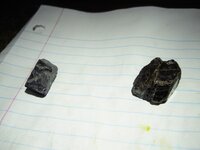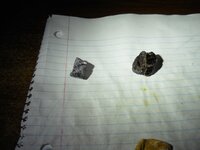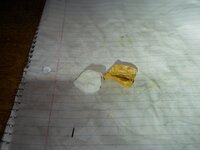I bought a box of rocks/minerals for the purpose of getting better at learning to identify them. It has 50 different items and I have identified most of them.
I'm left with 5. I can take some pictures but I thought I'd start the thread first and ask a few questions. By the way, this box of rocks originally was sold by Sargent Welsh company for home schooling purposes I think.
The items may be 1. black tourmaline 2. sphalerite 3. alabaster/gypsum 4. fluorite and 5. jasper
The two I'll discuss first are 2. sphalerite? and 3. alabaster?
Number 2. has a hardness of about 4, it has a metalic luster, and has cleavage (maybe 3 planes of cleavage?). For a streak test I used a black piece of sandpaper and the streak is tan. I have a piece of Galena for comparison. The Galena is heavier, shinier (more reflective and chrome looking) and has a dark streak by comparison on the same piece of sand paper.
Number 2 really looks like Galena if you replaces the sides of the "cubes" with Biotite. However when you get the light just right you see that it isn't black and is actually chrome like but it just doesn't reflect as easily as Galena. It doesn't look like most of the pictures I'm able to find of Sphalerite but the tests kind of point that way. I've also checked out Tetrahedrite. I really just don't know what it is. The Biotite look doesn't extend to flaking. It doesn't flake or peel like Biotite.
I'll post a picture of it soon.
Number 3 Alabaster? is a light ochre color on the surface but when scratched it's white. It's hardness is about 2 and it looks like most of my samples of Gypsum except for the surface color. All my samples are white and this is tan/yellowish but as mentioned when scratched it's white.
Is there some surface kind of oxidation or impurities common with Gypsum or Alabaster? At first glace I thought it was Limonite.
I'm sure I'll have to do better with the uploaded pictures but the block on the left is Galena and the one of the right is what I'm trying to figure out.
In the other picture the white item on the left is Gypsum and I'm wondering about the yellowish/tan item on the right.
Actually I now see that the pictures are very close up if you just click on each picture.
I'm left with 5. I can take some pictures but I thought I'd start the thread first and ask a few questions. By the way, this box of rocks originally was sold by Sargent Welsh company for home schooling purposes I think.
The items may be 1. black tourmaline 2. sphalerite 3. alabaster/gypsum 4. fluorite and 5. jasper
The two I'll discuss first are 2. sphalerite? and 3. alabaster?
Number 2. has a hardness of about 4, it has a metalic luster, and has cleavage (maybe 3 planes of cleavage?). For a streak test I used a black piece of sandpaper and the streak is tan. I have a piece of Galena for comparison. The Galena is heavier, shinier (more reflective and chrome looking) and has a dark streak by comparison on the same piece of sand paper.
Number 2 really looks like Galena if you replaces the sides of the "cubes" with Biotite. However when you get the light just right you see that it isn't black and is actually chrome like but it just doesn't reflect as easily as Galena. It doesn't look like most of the pictures I'm able to find of Sphalerite but the tests kind of point that way. I've also checked out Tetrahedrite. I really just don't know what it is. The Biotite look doesn't extend to flaking. It doesn't flake or peel like Biotite.
I'll post a picture of it soon.
Number 3 Alabaster? is a light ochre color on the surface but when scratched it's white. It's hardness is about 2 and it looks like most of my samples of Gypsum except for the surface color. All my samples are white and this is tan/yellowish but as mentioned when scratched it's white.
Is there some surface kind of oxidation or impurities common with Gypsum or Alabaster? At first glace I thought it was Limonite.
I'm sure I'll have to do better with the uploaded pictures but the block on the left is Galena and the one of the right is what I'm trying to figure out.
In the other picture the white item on the left is Gypsum and I'm wondering about the yellowish/tan item on the right.
Actually I now see that the pictures are very close up if you just click on each picture.
Attachments
Last edited:







